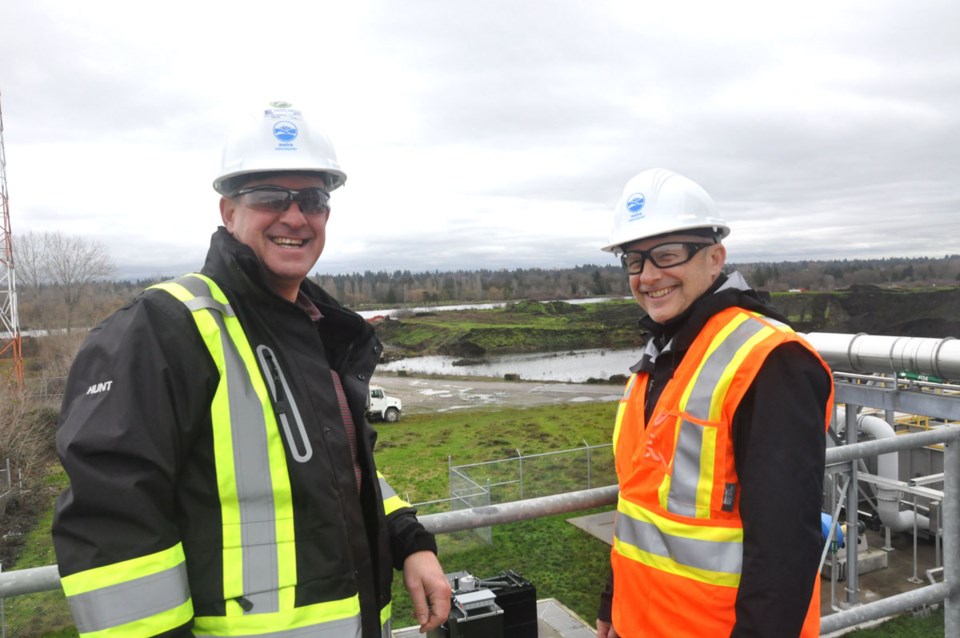The cost of replacing the wastewater treatment plant on Iona Island has been pegged at $1.9 billion and the process will be launched next week in Richmond at the first community engagement meeting.
The Iona Island Wastewater Treatment Plant, which opened in 1963, serves 600,000 residents and businesses in Richmond, Vancouver, UBC and some small areas of Burnaby, not just processing wastewater but dealing with copious amounts of rainwater as well. The replacement plant, scheduled to be built by 2030, is being planned so that it will last to the end of 21st century.
The federal government has mandated that all wastewater treatment plants must be secondary level by 2030. Primary treatment removes anything that settles or floats, like grease, but nothing that is dissolved, whereas a secondary treatment plant treats the water at a microbiological level and removes a substantially larger amount of waste, explained Fred Nenninger, director of policy planning and analysis with Metro Vancouver’s Liquid Waste Service.
“Primary is taking about 65 per cent of those materials in wastewater, and secondary gets about 95 to 98 per cent,” he added. Although research is still being done on microplastics being released into the ocean, using a secondary treatment plant seems to be taking out about 90 per cent of these small plastic pieces, he added.
The project definition phase, budgeted at $16.5 million, will be completed by the end of 2019 and will result in conceptual design and the project budget.
The plant will initially be built to accommodate population growth for the next 15 to 20 years, Nenninger explained, but the layout will be designed to add on as the population continues to grow to the end of the century.
“There’ll be expansions as the population grows, in 20-25 year intervals – we’ll keep pace by adding components,” he said.
Unlike other wastewater treatment plants, the Iona Island plant is a “wet-weather plant,” attached to an old sewer system in the city of Vancouver and parts of Burnaby and therefore it has to deal with a lot more storm water than other plants, Nenninger explained.
The long-term plan is to replace the entire plant, but, in the meantime, Metro Vancouver will build a temporary dewatering facility on the site to replace the sludge lagoons, which will then be integrated into the new plant.
According to a report to the city’s design panel, the dewatering facility will result in a “net gain” for the environmentally sensitive area.
Richmond Coun. Michael Wolfe said the dewatering facility was the first item dealing with the new treatment plant that he’s seen come to council, and he’s pleased that the plant will be upgraded to a secondary plant.
“The fact that we’re still putting primary treated waste into the estuary right where the young salmon are leaving the river system or the adults are coming back and hanging around and we’re pumping right into that water – highly chemical or hormone-rich waste water – it’s overdue,” Wolfe said.
While the treatment plant is a regional upgrade, Wolfe said there are some Richmond-specific aspects that he will advocate for, including opening up MacDonald Slough and protecting the habitat of nesting birds.
The road that goes directly to the treatment facility blocks the McDonald Slough from flowing out into the ocean. To support wildlife in the area, Wolfe said he’d like to see an overpass or a culvert at the McDonald Slough that would allow water both ways so that it would flow into the ocean once again and allow salmon to come back in.
“That road is partly to blame for the long-term decline of the salmon, in my mind, so I think it’s a necessary enhancement to the region,” Wolfe said.
The Raincoast Conservation group has projects in the Fraser River estuary that support the wildlife and ecosystem, and Wolfe sees the McDonald Slough tying into this project.
The area around the treatment centre is a ground nesting bird habitat and Wolfe hopes when the invasive species are removed, it’s done with sensitivity to their nesting time and under the “guiding eye” of a biologist.
This includes yellow-headed blackbirds, the red-winged blackbirds, killdeer, plovers, and small songbirds that nest in thickets or shrubs.
“Even though they’re invasives, they can provide critical habitat needs because our cities have sprawled so much and removed all their first-choice habitat and they’re left with nesting at the edge of a wastewater treatment facility because there’s nothing left for them,” Wolfe said.
The first community workshop for the Iona Island Wastewater Treatment Plant replacement project will be held on Wednesday, Jan. 9, 6 to 8:30 p.m. in the auditorium of the Pacific Autism Family Network, 3688 Cessna Dr.



